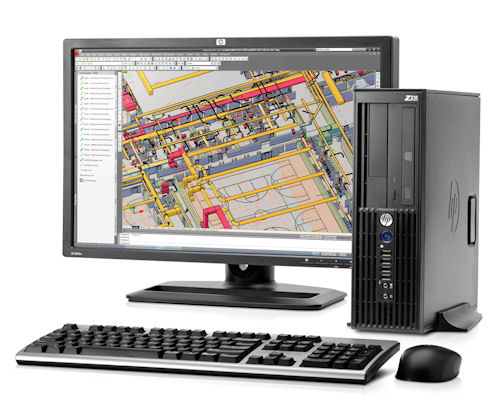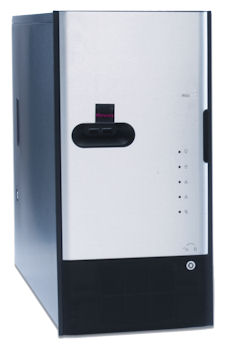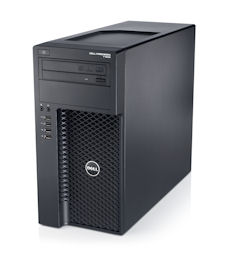Consumer PCs vs. Pro Workstations
Consumer brands cost less initially, but incompatibility with professional software may add costs down the road.
Latest News
September 1, 2012
By Kenneth Wong
On any given weekend, offers from local retailers arrive at your doorsteps—literally. Spilling out of a bloated Sunday paper, the special inserts from Best Buy and Fry’s compete for your attention, right alongside discount coupons from Safeway and Macy’s.
Looking at those consumer PCs listed for $400 to $600, you must have wondered: Why bother with a workstation that can set you back anywhere from $1,000 to $5,000? Why not grab a top-of-the-line consumer brand, add a couple gigabytes of memory, add a graphics processing unit (GPU), upgrade the storage to a couple of terabytes, and turn it into your own homegrown workstation?
 |
| HP’s entry-level professional workstation, the Z210, is priced below $1,000—a price point compatible with a top-of-the-line consumer model. |
Although the savings offered by this approach may be tempting, the resulting system may create unanticipated side effects. The unstable system may also jeopardize your work, prompting you to spend more time troubleshooting and rebooting.
There is, however, another option: The new entry-level workstations, often priced below $1,000, are developed and designed specifically to run professional software. They are a beginner’s workstation, with room to grow as the owner transitions from prosumer to professional.
Certified Stability
The three household names in the PC market—Dell, HP and Lenovo—all offer different brands targeting consumers and professionals. Dell’s dedicated consumer line is Inspiron; HP’s is Pavilion, and Lenovo’s are IdeaCenter and ThinkCenter. For professionals, Dell offers Precision workstations, HP offers Z-series workstations, and Lenovo offers ThinkStation workstations.
“A turbocharged, high-end consumer PC is certainly a powerful piece of equipment,” says Tom Salomone, HP’s marketing manager for workstations. “But it’s not intended for the types of applications that people use in design work.”
The stability of a system during CAD operations, Salomone points out, comes from “a lot of work from the ]system] manufacturer, in terms of testing drivers, testing out different applications to make sure things work … It’s called certification. It’s a lengthy process. Some can run up to four weeks.”
 |
| Microway’s professional workstation line, WhisperStation, begins at $1,800. |
There’s a tremendous amount of effort that goes on between independent software vendors (ISVs) and original equipment makers (OEMs), notes Richard Runnels, Dell’s vertical marketing strategist for the Precision product line: “Products are certified by the ISVs to work with a specific version of their software in a specific configuration of hardware … All of our Precision workstations are tested in that format. It provides customers with a level of security knowing that a particular hardware configuration is going to work with their software version.”
ISVs’ Role
Many ISVs see powerful Windows desktops—professional workstations in particular—as the ideal platform for operating high-end CAD programs, but some look to expand their reach by lowering the barrier of entry. In the case of Autodesk, the company is “committed to ensuring its solutions run on the minimum specifications we publish regardless of whether that hardware is considered consumer or professional,” according to Steve Hooper, senior product manager for Autodesk Product Design Suite, Manufacturing. Among major CAD developers, Autodesk is arguably the most enthusiastic in advocating the use of its software on all hardware platforms, including mobile tablets, cloud-hosted environments, and even Mac OS.
 |
| Dell’s entry-level workstation T1600 was later replaced with the T1650, shown here. |
However, there may be areas where a user cannot get peak performance from a modeling program when running a consumer system. Pete Lord, Autodesk’s senior product manager, Design, Lifecycle and Simulation (DLS) Product Group, pointed out, “Autodesk Inventor features direct 3D capability ]which doesn’t rely on special hardware to deliver visualization], so this is not a significant concern, but older generation graphics cards may not provide access to all of Inventor’s rich graphics capability … Inventor has added support for multicore computing in several areas. If a consumer computer doesn’t include multicore support, these performance benefits will be forgone.” Nevertheless, if you’re running Autodesk software on a system that meets minimum requirements, the company will offer tech support.
Visuals vs. Accuracy
Professional design programs usually take advantage of a GPU to display complex surfaces and assembly models with accuracy. In most consumer-brand PCs, the GPU upgrade options are limited to those developed for gaming, multimedia and entertainment—not ideal for design programs.
GPU maker NVIDIA, for example, offers the GeForce product line for consumers, and Quadro and Tesla for professionals. (Quadro is often used in individual workstations and Tesla in high-performance computing clusters; however, in the newer Maximus-class workstations, buyers have the option to deploy more than one GPU in a single machine to boost its parallel processing power.) NVIDIA’s rival Advanced Micro Devices also offers two distinct lines: Radeon for general consumers, and FirePro for professionals.
“A CAD application is a massive piece of software,” says HP’s Salomone. “It’s going to take control of your screen and calculate forms that are accurate in terms of geometry. Every CAD application is a little different in how it treats the visualization … In order to run something like that, you need stability in your system and in your graphics.”
“The ISVs I work with do not certify non-professional graphics cards,” says Dell’s Runnels. “When you play games, you’re looking for visuals; when you’re building a CAD model, it needs to be airtight so you can run analysis programs and later use that model for machining. For that, you need a level of complexity and error-correction significantly beyond a gaming graphics card.”
Eliot Eshelman, senior technical account manager at Microway, notes that professional GPUs feature dual-DMA, or dual copy, engines—“allowing data to simultaneously move in and out of GPU memory. Consumer products move data in only one direction at a time, which reduces performance and lowers frame rates. Other functions, which are never needed in games, but frequently required by professional applications, are completely missing from consumer cards.”
Error Detection and Correction
Almost all professional workstations come preloaded with error correction code (ECC) memory, marked by its inherent ability to detect and correct errors. Engineering applications—and finite element analysis (FEA) programs in particular—rely heavily on the memory footprint to calculate, solve and process complex algorithms in digital prototyping exercises. Therefore, ECC memory provides added assurance of the accuracy of the results. ECC memory finds and fixes 99.988% of all soft memory errors, according to Intel.
Wes Shimanek, Intel’s workstation segment manager, technical computing group, points out that while most users just don’t want to believe an error will occur, “a study by Lambda Diode would make you think twice: It suggests that there is a 96% chance you will experience a memory error every three days. If you are not using the part of the memory that failed, you do not notice it. But the worst part is, if it is a soft error, you do not see it, either—and that can be catastrophic.”
“The consumer equipment generally has lower ceilings on system memory,” says Microway’s Eshelman. “Will the engineer’s models fit? Error-correcting memory is usually only available on professional equipment. Can the engineer get by when single-bit errors go unnoticed and change the results of simulations?”
Starter Workstations
In mid-2011, PC vendors began delivering a new type of workstation, targeted at budget-conscious buyers. HP’s first product was the Z210, priced beginning from $569. Dell’s entry-level desktop tower, the T1650, was priced at $549.
Microway concentrates on servers, storage devices, and professional workstations. Its WhisperStation workstations are priced beginning at $1,829.
Consumer PCs undeniably offer price advantage in initial investment, but bear in mind that workstations are usually investments in revenue-generating professional activities. In the long run, the number of unexpected errors and system crashes resulting from running professional software on an unsanctioned hardware platform may undo the initial saving that comes with a turbocharged consumer PC.
“Intel Xeon processor-based workstations are much more than a turbocharged PC. They are workload-optimized innovation platforms that today are surprisingly affordable when compared to a PC,” says Frank Soqui, Intel’s workstation general manager, technical computing group. “Sure, you can save a few dollars in hardware by buying a PC, but the money you save up front will probably be eroded in less than three months in the lost time while engineers wait for results from high-value activities (e.g. simulations or ray-traced images) that play an enormous part in product decisions.”
Microway’s Eshelman agrees. “Often a workstation purchased from a vendor who specializes in customized, professional configurations will outperform the top end of a consumer stock-keeping unit,” he concludes. “While such systems may seem expensive up front, they will perform for years—and save you time, energy and money in the long run.”
Kenneth Wong is Desktop Engineering’s resident blogger and senior editor. Email him at [email protected] or share your thoughts on this article at deskeng.com/facebook.
More Info
Advanced Micro Devices
Autodesk
Dell
HP
Intel
Lambda Diode
Lenovo
Microway
NVIDIA
Subscribe to our FREE magazine, FREE email newsletters or both!
Latest News
About the Author
Kenneth Wong is Digital Engineering’s resident blogger and senior editor. Email him at [email protected] or share your thoughts on this article at digitaleng.news/facebook.
Follow DE





